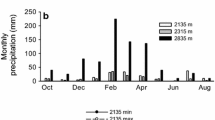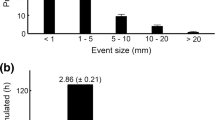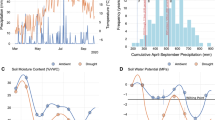Abstract
For much of the western USA, precipitation occurs in pulses, the nature of which determine soil water potential and plant physiological performance. This research utilized three experiments to examine the sensitivity of photosynthesis and water relations for two widespread Great Basin Desert shrub species, Artemisia tridentata (which has both deep and shallow roots) and Purshia tridentata (which reportedly has only deep roots), to (1) variation in pulse magnitude size, (2) the kinetics of responses to pulses, and (3) the relationship between pulse-size and antecedent soil water content. At the study site in the southwestern Great Basin Desert, USA, summer rainfall exhibits a greater frequency of larger-sized events, and longer inter-pulse intervals, compared to annual patterns. Compared to pre-watering values, stem water potential initially increased by about 2.00 MPa for A. tridentata and 1.00 MPa for P. tridentata following watering to simulate an 11.5 mm rainfall pulse. For the same water addition, stomatal conductance increased by 0.3 mol m−2 s−1 and photosynthetic CO2 assimilation increased 8-fold for A. tridentata and 6-fold for P. tridentata. Water potential and photosynthetic gas exchange were maximal for both species 2–3 days following a pulse addition. In comparison to P. tridentata, the increase in photosynthesis for A. tridentata was more pronounced for plants treated incrementally with several small pulses compared to plants treated with one pulse of an equivalent total volume. The results indicate that both species can respond to a range of summer rainfall pulse magnitudes within about 2 days, with A. tridentata generally exhibiting larger responses in comparison to the co-dominant shrub species P. tridentata, which at this study site does indeed have shallow roots. In a future climate, the timing and magnitude of summer rainfall pulses will determine the extent to which these two species undergo changes in water status and photosynthetic carbon uptake, with implications for their fitness.





Similar content being viewed by others
References
Arritt RW, Goering DC, Anderson CJ (2000) The North American monsoon system in the Hadley Centre coupled ocean-atmosphere GCM. Geophys Res Lett 27:565–568
Anderson BT, Roads JO (2002) Regional simulation of summertime precipitation over the southwestern United States. J Clim 15:3321–3342
Baker D, Torrey JG (1979) The isolation and cultivation of actinomycetous root nodule endophytes. In: Gordon JC, Wheeler CT, Perry DA (eds) Symbiotic nitrogen fixation in the management of temperate forests: Proceedings of a workshop, Corvallis, OR. Oregon State University, Forest Research Laboratory, pp 38–56
BassiriRad H, Tremmel DC, Virginia RA, Reynolds JF, de Soyza AG, Brunell MH (1999) Short-term patterns in water and nitrogen acquisition by two desert shrubs following a simulated summer rain. Plant Ecol 145:27–36
Caldwell MM, Manwaring JH, Jackson RB (1991a) Exploitation of phosphate from fertile soil microsites by 3 Great Basin perennials when in competition. Funct Ecol 5:757–764
Caldwell MM, Manwaring JH, Durham SL (1991b) The microscale distribution of neighboring plant-roots in fertile soil microsites. Funct Ecol 5:765–772
Caldwell MM, Richards JH (1989) Hydraulic lift—water efflux from upper roots improves effectiveness of water-uptake by deep roots. Oecologia 79:1–5
Dawson TE (1993a) Hydraulic lift and water-use by plants—implications for water-balance, performance and plant-plant interactions. Oecologia 95:565–574
Dawson TE (1993b) Woodland water-balance. Trends Ecol Evol 8:120–121
Dawson TE, Ehleringer JR (1991a) Ecological correlates of seed mass variation in Phoradendron juniperinum, a xylem-tap** mistletoe. Oecologia 85:332–342
Dawson TE, Ehleringer JR (1991b) Streamside trees that do not use stream water. Nature 350:335–337
Easterling DR, Meehl GA, Parmesan C, Changnon SA, Karl TR, Means LO (2000) Climate extremes: observations, modeling, and impacts. Science 289:2068–2074
Evans RD, Black RA, Link SO (1991) Reproductive growth during drought in Artemisia tridentata Nutt. Funct Ecol 5:676–683
Field CB, Dailey GC, Davis FW, Gaines S, Melack J, Miller NL (1999) Confronting climate change: impacts on the golden state. Union of Concerned Scientists, Cambridge, MA and Ecological Society of America, Washington, DC
Flanagan LB, Ehleringer JR, Marshall JD (1992) Differential uptake of summer precipitation among co-occurring trees and shrubs in a pinyon-juniper woodland. Plant Cell Environ 15:831–836
Gebauer RLE, Ehleringer JR (2000) Water and nitrogen uptake patterns following moisture pulses in a cold desert community. Ecology 81:1415–1424
Golluscio RA, Sala OE, Lauenroth WK (1998) Differential use of large summer rainfall events by shrubs and grasses: a manipulative experiment in the Patagonian steppe. Oecologia 115:17–25
Hayhoe K, Cayan D, Field CB, Frumhoff PC, Maurer EP, Miller NL, Moser SC, Schneider SH, Cahill KN, Cleland EE, Dale L, Drapek R, Hanemann RM, Kalkstein LS, Lenihan J, Lunch CK, Neilson RP, Sheridan SC, Verville JH (2004) Emissions pathways, climate change, and impacts on California. Proc Natl Acad Sci USA 101:12422–12427
Huxman TE, Snyder KA, Tissue D, Leffler AJ, Ogle K, Pockman WT, Sandquist DR, Potts DL, Schwinning S (2004) Precipitation pulses and carbon fluxes in semiarid and arid ecosystems. Oecologia 141:254–268
Ivans CY, Leffler AJ, Spaulding U, Stark JM, Ryel RJ, Caldwell MM (2003) Root responses and nitrogen acquisition by Artemisia tridentata and Agropyron desertorum following small summer rainfall events. Oecologia 134:317–324
Jackson RB, Carpenter SR, Dahm CN, McNight DM, Naiman RJ, Postel SL, Running SW (2001) Water in a changing world. Ecol Appl 11:1027–1045
Knapp AK, Fay PA, Blair JM, Collins SL, Smith MD, Carlisle JD, Harper CW, Danner BT, Lett MS, McCarron JK (2002) Rainfall variability, carbon cycling, and plant species diversity in a mesic grassland. Science 298:2202–2205
Gebauer RLE, Schwinning S, Ehleringer JR (2002) Interspecific competition and resource pulse utilization in a cold desert community. Ecology 83:2602–2616
Leffler AJ, Caldwell MM (2005) Shifts in depth of water extraction and photosynthetic capacity inferred from stable isotope proxies across an ecotone of Juniperus osteosperma (Utah juniper) and Artemisia tridentata (big sagebrush). J Ecol 93:783–793
Loik ME, Breshears DD, Lauenroth WK, Belnap J (2004) A multi-scale perspective of water pulses in dryland ecosystems: climatology and ecohydrology of the western USA. Oecologia 141:269–281
Loik ME, Nobel PS (1991) Water relations and mucopolysaccharide increases for a winter hardy cactus during acclimation to subzero temperatures. Oecologia 88:340–346
McConnell BR (1961) Notes on some rooting characteristics of antelope bitterbrush. Res. Note No. 204. Portland, OR: U.S. Department of Agriculture, Forest Service, Pacific Northwest Forest and Range Experiment Station
National Assessment Synthesis Team (2000) Climate change impacts on the United States: the potential consequences of climate variability and change. US Global Change Research Program. Cambridge University Press, New York, New York, USA
Naumburg E, Mata-Gonzalez R, Hunter RG, Mclendon T, Martin DW (2005) Phreatophytic vegetation and groundwater fluctuations: a review of current research and application of ecosystem response modeling with an emphasis on Great Basin vegetation. Environ Manage 35:726–740
Nobel PS, Sanderson J (1984) Rectifier-like activities of roots of two desert succulents. J Exp Bot 35:727–737
Novoplansky A, Goldberg DE (2001) Effects of water pulsing on individual performance and competitive hierarchies in plants. J Veg Sci 12:199–208
Noy-Meir I (1973) Desert ecosystems: environment and producers. Annu Rev Ecol Syst 4:25–52
Potts DL, Huxman TE, Cable JM, English NB, Ignace DD, Eilts JA, Mason MJ, Weltzin JF, Williams DG (2006) Antecedent moisture and seasonal precipitation influence the response of canopy-scale carbon and water exchange to rainfall pulses in a semi-arid grassland. New Phytol 170:849–860
Reynolds JF, Virginia RA, Kemp PR, De Soyza AG, Tremmel DC (1999) Impact of drought on desert shrubs: effects of seasonality and degree of resource island development. Ecol Monogr 69:69–106
Richards JH, Caldwell MM (1987) Hydraulic lift–substantial nocturnal water transport between soil layers by Artemisia tridentata roots. Oecologia 73:486–489
Rundel PW, Nilsen ET, Sharifi MR, Virginia RA, Jarrell WM, Kohl DH, Shearer GB (1982) Seasonal dynamics of nitrogen cycling for a prosopis woodland in the Sonoran Desert. Plant Soil 67:343–353
Ryel RJ, Leffler AJ, Peek MS, Ivans CY, Caldwell MM (2004) Water conservation in Artemisia tridentata through redistribution of precipitation. Oecologia 141:335–345
Sala OE, Lauenroth WK (1982) Small rainfall events—an ecological role in semi-arid regions. Oecologia 53:301–304
Sala OE, Lauenroth WK, Parton WJ (1992) Long-term soil–water dynamics in the shortgrass steppe. Ecology 73:1175–1181
Schenk HJ, Callaway RM, Mahall BE (1999) Spatial root segregation: are plants territorial? Adv Ecol Res 28:145–180
Schwinning S, Davis K, Richardson L, Ehleringer JR (2002) Deuterium enriched irrigation indicates different forms of rain use in shrub/grass species of the Colorado Plateau. Oecologia 130:345–355
Schwinning S, Ehleringer JR (2001) Water use trade-offs and optimal adaptations to pulse-driven arid ecosystems. J Ecol 89:464–480
Schwinning S, Sala OE (2004) Hierarchy of responses to resource pulses in and semi-arid ecosystems. Oecologia 141:211–220
Schwinning S, Sala OE, Loik ME, Ehleringer JR (2004) Thresholds, memory, and seasonality: understanding pulse dynamics in arid/semi-arid ecosystems. Oecologia 141:191–193
Seney JP, Gallegos JA (1995) Soil survey of inyo national forest, west area, California. United States Forest Service, Pacific Southwest Region
Smith SD, Nowak RS (1990) Ecophysiology of plants in the Intermountain lowlands. In: Osmond CB, Pitelka LF, Hidy GF (eds) Plant biology of the basin and range. Springer-Verlag, New York, pp 179–241
Snyder KA, Donovan LA, James JJ, Tiller RL, Richards JH (2004) Extensive summerwater pulses do not necessarily lead to canopy growth of Great Basin and northern Mojave Desert shrubs. Oecologia 141:325–334
Snyder MA, Bell JL, Sloan LC, Duffy PB, Govindasamy B (2002) Climate responses to a doubling of atmospheric carbon dioxide for a climatically vulnerable region. Geophys Res Lett 29:1510–1514
Stephenson NL (1990) Climatic control of vegetation distribution: the role of the water balance. Am Nat 135:649–670
Weltzin JF, McPherson GR (1997) Spatial and temporal soil moisture resource partitioning by trees and grasses in a temperate savanna, Arizona, USA. Oecologia 112:156–164
Weltzin JF, McPherson GR (2003) Precipitation and terrestrial ecosystems. University of Arizona Press, Tucson, Arizona
West NE (1988) Intermountain deserts, shrub steppes, and woodlands. In: Barbour MB, Billings WD (eds) North American terrestrial vegetation. Cambridge University Press, New York, pp 209–230
Wilcox BP, Breshears DD, Allen CD (2003a) Ecohydrology of a resource-conserving semiarid woodland: effects of scale and disturbance. Ecol Monogr 73:223–239
Wilcox BP, Breshears DD, Turin HJ (2003b) Hydraulic conductivity in a pinon-juniper woodland: influence of vegetation. Soil Sci Soc Am J 67:1243–1249
Williams DG, Ehleringer JR (2000) Intra- and interspecific variation for summer precipitation use in pinyon-juniper woodlands. Ecol Monogr 70:517–537
Young JA, Clements CD (2002) Purshia: the wild and bitter roses. University of Nevada Press, Reno, Nevada, USA
Zou CB, Barnes PW, Archer S, McMurtry CR (2005) Soil moisture redistribution as a mechanism of facilitation in Savanna tree-shrub clusters. Oecologia 145:32–40
Acknowledgments
Many thanks to Dan Dawson and the staff of the Valentine Eastern Sierra UC Natural Reserve for scientific and logistical support. The Inyo National Forest (USDA United States Forest Service) provided permission to use study sites adjacent to VESR. Funding was provided by a grant from the Durfee Foundation to the Student Challenge Awards Program of Earthwatch, and from the University of California, Santa Cruz. This work would not have been possible without the enthusiastic contributions of Ian Gillespie, Hally Andersen, Gitane Royce, Alden Griffith, Grey Hayes, Karen Holl, and the 2000–2002 SCAP Teams
Author information
Authors and Affiliations
Corresponding author
Rights and permissions
About this article
Cite this article
Loik, M.E. Sensitivity of water relations and photosynthesis to summer precipitation pulses for Artemisia tridentata and Purshia tridentata . Plant Ecol 191, 95–108 (2007). https://doi.org/10.1007/s11258-006-9217-1
Received:
Accepted:
Published:
Issue Date:
DOI: https://doi.org/10.1007/s11258-006-9217-1




